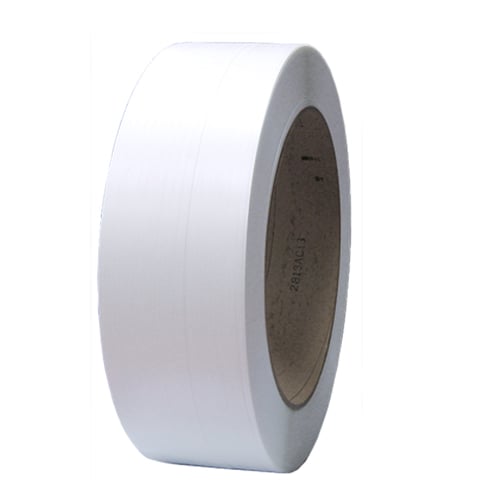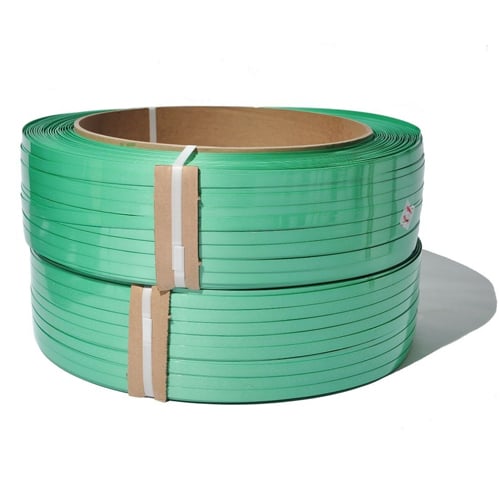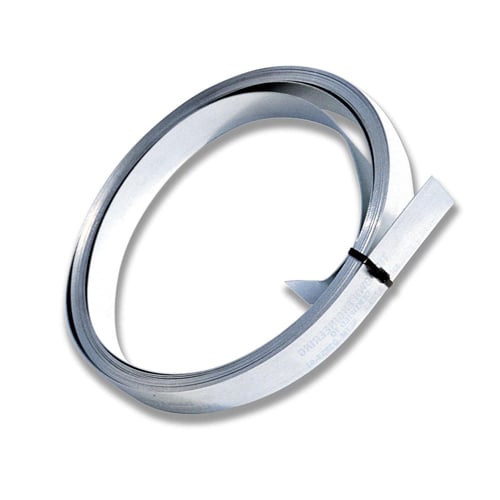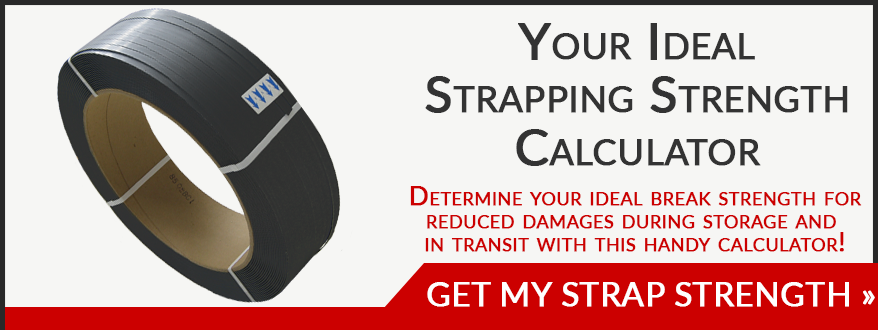The Top 3 Types Of Strapping Material And Their Uses
Packaging Materials | Shipping Protection | Food Packaging | Warehousing
You know that strapping can be used to bundle products together, reinforce cartons, and to secure items to pallets for shipment. These strapping materials come in a variety of options, but how do you know which is best for your application? Your options can be filtered down into three primary categories: polypropylene(PP), polyester(PET), and steel.
Strapping materials are used primarily for bundling products together and securing pallet loads during transport and storage. When used for palletizing, it is often complemented with the additional security of stretch wrap. Being a market leader in supplying strapping materials to companies of all sizes, we've been able to help many brands overcome the challenges of securing your products from shipment to shelf.
You might find yourself with a lot of questions when trying to find the best strapping material for you.
Which type of strapping material is ideal for your application, and how does it function?
What is the difference between virgin and recycled strapping?
Find out how these materials work and which will be the best fit to optimize the security and unitizing of your products..
Polypropylene Strapping And Its Uses
Polypropylene (PP) strapping is one of the most common types of strapping and comes in a variety of tensile strengths, widths, and core sizes depending on your application.
It’s almost always embossed, giving it additional strength and texture for better friction. Embossing also significantly reduces dust created during the strapping process.
Polypropylene strapping can be applied manually with buckles or hand tools up to fully automated strapping machines.
PP strapping stretches around 25% when applying, however, it recovers about 10% back shortly after. As a package or pallet settles, the strap will retain some tension. Polyester and steel will not recover as your package/pallet settles.
Unless otherwise formulated, plain PP strap can be sensitive to UV light degradation and is sometimes negatively impacted by elevated temperatures. By selecting the proper formulation of PP strapping with your supplier, you won't have to worry about these downsides.

Some new formulations negate most of these issues. Dynaric/PolyChem's Ultraband polyester strapping can handle weighty loads, up to 2000 lbs of tensile strength! But it does have a higher price point. Most alternative PP strapping materials are generally less expensive than Polyester (PET), making them very economical.
Best Uses For Polypropylene Strapping
Polypropylene strapping is exceptionally versatile and can be used on various applications including:
- Printed Materials (Newspapers, Magazines)
- Direct mail
- Millwork (moldings, banisters, etc.)
- Flooring (hardwoods, laminates)
- Appliances
- Clothing
- Foods (Distribution centers that supply grocery stores)
- Meats, produce, and other fresh and frozen food packers
- Pharmaceutical and Drug Store Distribution Centers
- Hay baling
The list above should give you the overall idea. Polypropylene can be used in almost any strapping application! In one of our customer applications, a 2,000 pound cradled load is easily secured with four straps!
Polyester Strapping
Polyester (PET) strapping is generally smooth in texture, but can also be embossed. Most Polyester strapping is created from recycled materials.
Fun Fact: You will notice that most PET strapping is green. This color is due to being created from plastic bottles. Most ginger-ale bottles and 7-UP® are green, and these significantly impact the color!

Heavy-duty polyester strapping has a higher tensile strength than steel and has decent thermal tolerance. It also has a lesser amount of tension decay over PP, which means it holds the tension for a longer period of time. This is important to keep in mind for cross-country hauls from one destination to another, or multiple stops along the path to the load's final destination.
There is also a polyester corded strapping, which is easily tied by hand with a wire buckle. It is a cloth material glued together, so there is no stretch available, but it is very flexible.
There are new formulations available as well such as Dynaric/PolyChem's Ultraband polyester strapping which can handle weighty loads, up to 2000 lbs of tensile strength. This strapping does have a higher price point though.
Best Uses For Polyester Strapping
Polyester strapping is best used for rigid loads and helps to absorb impact during transit. It's also a better alternative when you need higher initial tension to contain loads when compared to PP strapping.
- Metals
- Lumber
- Pallets of Bottles and Cans
- Bricks
- Tiles
- Excellent for stabilizing and palletizing heavy loads
Want to learn more about protective packaging options to secure your products from production to its destination? We created the ultimate guide to protective packaging for you!
Steel Strapping
Steel strapping is becoming a lesser-used option, but has historically been utilized in mostly railroad-shipped applications. It is required by the government (Association of American Railroads) for railroad transport where the load is not held within a container.
There are a few AAR-approved PP or PET strapping options available, so if you prefer one of these, inquire with us about your options! Few places use steel for packaging that cannot use PP or PET strapping. Most steel strapping is made of stainless steel.
When bent at a right angle, like wrapping around the edges of a pallet, for example, steel strapping loses half of its strength.

Best Uses For Steel Strapping
Steel strapping is the oldest and most heavy-duty of the top 3 strapping material options. It is best used in heavy-duty applications. Steel does not expand or contract with the load, once it is secured, it stays!
- Heavy manufacturing and industrial equipment
- Steel coils
- Construction Materials
- Bundling metals
- Baling wire
- Secure Closure of Metal Containers
- Railroad Shipping
What Factors Should I Consider When Choosing Strapping Material?
Product Dimensions
The most important factors to consider when selecting your strapping material will be the size, weight, and oddly enough awkwardness of your product. An example of a product that’s very awkward to package would be a refrigerator.
When shipped, refrigerators are usually strapped to a pallet that is the same width of the base. With fridges being top-heavy, you will want to make sure you have enough strength in your strapping to maintain stability in transit.
Some businesses want to over-strap for added security. However, with the right-sized, proper material, you can reduce wasted material and secure your loads properly.
Shipping Distance
If your product is shipping long distances, you will want a more sturdy strap to resist the transport movement. Consider the width of strapping when considering shipment as well. For a long haul carrying a heavy load, you will not want to use 1/4" wide strap. The thinner strap will not have the strength to manage the load, so you will want something with more width and strength.
The more likely your products are to shift during travel, the wider the strapping you will want to use. If your products tend to settle during shipment (printed materials, for example), polypropylene is an excellent option because it can stretch and maintain integrity. Polyester is less likely to stretch.
Tensile Strength
Tensile strength is the amount of force required to break a strap. The break strength is dependent upon the method of strapping, the number of straps used per load, the size of the strapping, and the overall weight of the products being strapped. It's essential to speak with your supplier about optimal strap sizing to eliminate breaking.
Method of Strapping
How you strap your products is very important in selecting the ideal strapping material. If you are only strapping ten shoe-box- sized products a day, manual strapping tools are a perfect option. If you are strapping 100 shoe-sized boxes per day, you will want to consider a semiautomatic or automatic machine.
There are TONS of options available in machinery to find the ideal match for your application. Automatic machinery can handle around three straps per minute and up to 1,000 per day.
Most heavy-duty applications are strapped manually with strapping tools
Virgin vs Recycled Strapping
When considering machine strapping, you will be best-suited with virgin strapping material. Virgin strapping differs from recycled strapping in how it's created and how it can be used. Virgin strapping is produced purely from new polymers and practically eliminates camber. Virgin strap also reduces the amount of dust created by semi and automatic machines, reducing downtime and maintenance costs. Using machinery, a recycled strap will often have irregularities, or camber.
Camber is the amount of curve or irregularity in strapping. When using machinery, it's essential to have as little camber as possible to reduce machinery issues during the strapping process. If you are strapping manually, the camber is not as much of a problem. Too much camber can cause the strap to come out of place, causing damage to the machinery and create safety hazards.
Although recycled strap is around half the cost of virgin strapping material, its important to consider consistency over initial expense. Machinery damaged from recycled strapping will cost more in the long haul for repairs than sticking with the ideal virgin strapping solution.
Most white strapping is virgin material and machine-grade. Black strapping is almost always going to have some re-processed materials within it.
Choosing The Right Strapping Material
With all of the information provided above, you should be in an excellent place to start your strapping selection! Our years in business and knowledge will give you a step ahead, so get in touch with our team. We can discuss your project and determine the ultimate sizing, pricing, and tools to set you up to strapping with ease.
Strapping is an excellent material for protecting your products in transit and storage. If it sounds like the right option for you, let's start a conversation!
Are you interested in learning more about protective packaging options? This guide is a great source that covers many other types of protective packaging that will keep your products safe throughout their journey!
About David Roberge
I am grateful to be part of the outstanding Industrial Packaging team. I am able to hang out with some of the most knowledgeable folks in the packaging industry. I feel even luckier that I am able to share that knowledge with you. I love learning, hiking, and growing people and teams both personally and professionally, and helping companies grow better.




